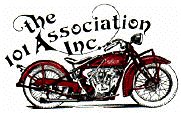I use page 41 A in the R&O for the description.
The bronze tube(38) has od 3/4", id 1/2" and upper length to the reduction approx 13/16". The reduced part diam is hard to measure but it goes precise through the spring eye (27). The reduction length is somewhere 7/16" when not riveted. The tube is riveted firmly to the spring eye together with washers (39) both above and under the spring eye. The picture in the R&O should show 4 washers (39).
(39) od is 1.1/8", id same as tube reduction and thickness approx 1/16". The inner spring (37) goes over the bronze tube and is resting on the top washer. Washer (34) is put under the spring on the yoke together with the nuts (33) and only there for wear reduction. Lock nut is imperative. I also use locktite on all threads in the seat assembly.
Springs (27) should be turned in opposite way for the left and right side. On my bike the right side is turned clockwise but I can't say if that is correct. I think there was different grades of springs to buy for heavy riders. A distance under the inner spring can be used, and the saddle plate has 3 holes for tuning the spring rate. 1931 yr. 101 had 2 rubber bumpers mounted on the support plate on the frame.
Seat springs can also be found with a very small eye at the bottom, and they are bolted firmly to the yoke in that version. Those springs are mostly fitted on the Mesinger tandem seat or other version seats that does not have the double springs found in the 101 seat. Such tandem seats can also be found with springs twice the length of the regular 101 spring.


